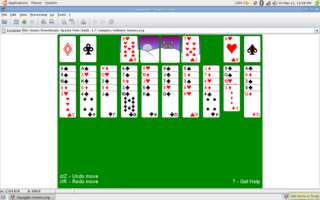Route 495 is a 3.45-mile-long (5.55 km) freeway in Hudson County, New Jersey, in the United States that connects the New Jersey Turnpike at exits 16E and 17 in Secaucus to New York State Route 495 (NY 495) inside the Lincoln Tunnel in Weehawken, providing access to Midtown Manhattan in New York City. The road is owned and operated by the New Jersey Turnpike Authority (NJTA) between the New Jersey Turnpike and Route 3, the New Jersey Department of Transportation (NJDOT) between Route 3 and Park Avenue near the Union City–Weehawken border, and by the Port Authority of New York and New Jersey (PANYNJ) east of Park Avenue, including the helix used to descend the New Jersey Palisades to reach the entrance of the Lincoln Tunnel. Route 495 is mostly a six-lane freeway with a reversible bus lane used during the morning rush hour. The bus lane, which runs the entire length of the freeway, continues into the Lincoln Tunnel's center tube.
Adl is an Arabic word meaning justice.
Bikol or Bicol usually refers to:
A bus stop is a place, other than a terminal, established for buses to pick up and drop off passengers

The Port Authority Bus Terminal is a bus terminal serving interstate buses traveling into Manhattan, New York City. The terminal is the largest in the Western Hemisphere and the busiest in the world by volume of traffic, serving about 8,000 buses and 225,000 people on an average weekday and more than 65 million people a year.
XBL is an XML-based markup language for altering the behavior of XUL widgets. It was devised at Netscape in the late 1990s as an extension of XUL.

A bus lane or bus-only lane is a lane restricted to buses, often on certain days and times, and generally used to speed up public transport that would be otherwise held up by traffic congestion. Bus lanes are a key component of a high-quality bus rapid transit (BRT) network, improving bus travel speeds and reliability by reducing delay caused by other traffic.
The Mozilla application framework is a collection of cross-platform software components that make up the Mozilla applications. It was originally known as XPFE, an abbreviation of cross-platform front end. It was also known as XPToolkit. To avoid confusion, it is now referred to as the Mozilla application framework.
In transport engineering nomenclature, a counterflow lane or contraflow lane is a lane in which traffic flows in the opposite direction of the surrounding lanes.

Microsoft Points, introduced in November 2005 as Xbox Live Points, were a digital currency issued by Microsoft for use on its Xbox and Zune product lines. Points could be used to purchase video games and downloadable content from Xbox Live Marketplace, digital content such as music and videos on Zune Marketplace, along with content from Windows Live Gallery.
sXBL is a mechanism for defining the presentation and interactive behavior of elements described in a namespace other than SVG's. sXBL is very similar to XBL, as it does for SVG documents what XBL does for XUL documents. For example, it is possible to define a generic scrollArea in sXBL and use it in SVG documents.

Batik is a pure-Java library that can be used to render, generate, and manipulate SVG graphics. IBM supported the project and then donated the code to the Apache Software Foundation, where other companies and teams decided to join efforts. Batik provides a set of core modules that provide functionality to:

Bus rapid transit in New Jersey comprises limited-stop bus service, exclusive bus lanes (XBL) and bus bypass shoulders (BBS). Under the banner Next Generation Bus New Jersey Transit (NJT), the New Jersey Department of Transportation (NJDOT), and the metropolitan planning organizations of New Jersey (MPO) which recommend and authorize transportation projects are undertaking the creation of several additional bus rapid transit systems (BRT) in the state. In 2011, NJT announced that it would equip its entire bus fleet with devices for real-time locating, thus creating the basis for "next bus" scheduling information at bus shelters. The introduction and expanded use of bus rapid transit in Garden State is part of worldwide phenomenon to bring mass transit to heavily trafficked corridors in both high and medium density areas as a cost-saving, and sometimes more flexible, alternative to rail transportation, thus reducing automobile dependency and traffic congestion.
This page is based on this
Wikipedia article Text is available under the
CC BY-SA 4.0 license; additional terms may apply.
Images, videos and audio are available under their respective licenses.



